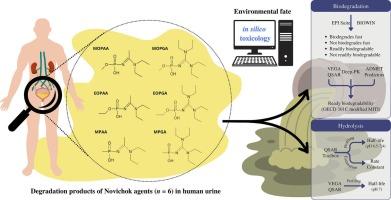The environmental fate of Novichok degradation products: application of in silico methods for the prediction of hydrolysis and biodegradation
IF 9.7
1区 环境科学与生态学
Q1 ENVIRONMENTAL SCIENCES
引用次数: 0
Abstract
Novichoks are highly toxic organophosphorus nerve agents, and their environmental degradation products remain poorly understood. This study presents the first comprehensive in silico evaluation of hydrolysis and biodegradation potential for six identified Novichok degradation products using QSAR Toolbox, EPI Suite (Biowin), VEGA QSAR, Deep-PK, and ADMET Predictor. Hydrolysis modeling showed that MOPAA, EOPAA, MOPGA, and EOPGA degrade rapidly (half-life ≈ 2.6 days), while MPAA and MPGA hydrolyze more slowly (half-life ≈ 38.6 days). The predicted hydrolysis rate constants (Kn) ranged from 1.73/day to 7.53/day. Biodegradation predictions from Biowin models indicated moderate persistence, with ultimate degradation occurring within weeks to months and no compound classified as readily biodegradable under OECD 301C. VEGA, Deep-PK, and ADMET Predictor confirmed these outcomes, with 76–95 % confidence. Anaerobic biodegradation potential was also moderate. Structure–activity relationship analysis revealed that smaller alkyl groups and phosphate residues promoted faster degradation, whereas phosphonates and branched structures conferred greater stability. These results indicate that some degradation products may persist in the environment and pose long-term risks. The study enhances understanding of Novichok byproducts’ environmental fate and demonstrates the value of computational methods in toxicological risk assessment and chemical defense planning. Experimental validation is recommended to confirm the predictions.

诺维乔克降解产物的环境命运:应用计算机方法预测水解和生物降解
诺维乔克是一种剧毒的有机磷神经毒剂,对其环境降解产物了解甚少。本研究首次使用QSAR工具箱、EPI Suite (Biowin)、VEGA QSAR、Deep-PK和ADMET Predictor对六种已确定的诺维乔克降解产物的水解和生物降解潜力进行了全面的计算机评估。水解模型表明,MOPAA、EOPAA、MOPGA和EOPGA降解速度快(半衰期≈2.6 天),而MPAA和MPGA水解速度较慢(半衰期≈38.6 天)。预测的水解速率常数(Kn)范围为1.73 ~ 7.53/d。Biowin模型的生物降解预测表明,持久性中等,最终降解发生在几周到几个月内,没有化合物被经合组织301C分类为易于生物降解。VEGA、Deep-PK和ADMET Predictor证实了这些结果,置信度为76-95 %。厌氧生物降解潜力也中等。构效关系分析表明,较小的烷基和磷酸残基促进了更快的降解,而磷酸盐和支链结构则具有更好的稳定性。这些结果表明,一些降解产物可能在环境中持续存在,并构成长期风险。该研究增强了对诺维乔克副产物环境命运的认识,并证明了计算方法在毒理学风险评估和化学防御规划中的价值。建议进行实验验证以证实预测。
本文章由计算机程序翻译,如有差异,请以英文原文为准。
求助全文
约1分钟内获得全文
求助全文
来源期刊

Environment International
环境科学-环境科学
CiteScore
21.90
自引率
3.40%
发文量
734
审稿时长
2.8 months
期刊介绍:
Environmental Health publishes manuscripts focusing on critical aspects of environmental and occupational medicine, including studies in toxicology and epidemiology, to illuminate the human health implications of exposure to environmental hazards. The journal adopts an open-access model and practices open peer review.
It caters to scientists and practitioners across all environmental science domains, directly or indirectly impacting human health and well-being. With a commitment to enhancing the prevention of environmentally-related health risks, Environmental Health serves as a public health journal for the community and scientists engaged in matters of public health significance concerning the environment.
 求助内容:
求助内容: 应助结果提醒方式:
应助结果提醒方式:


